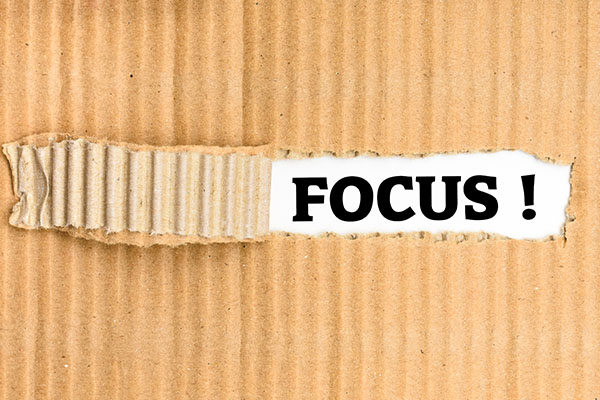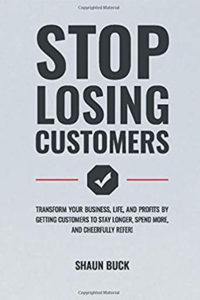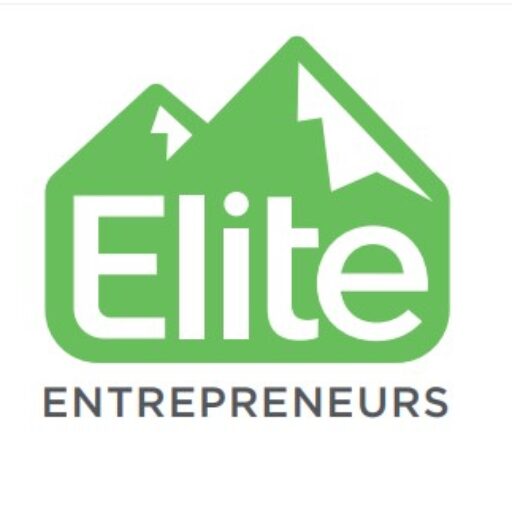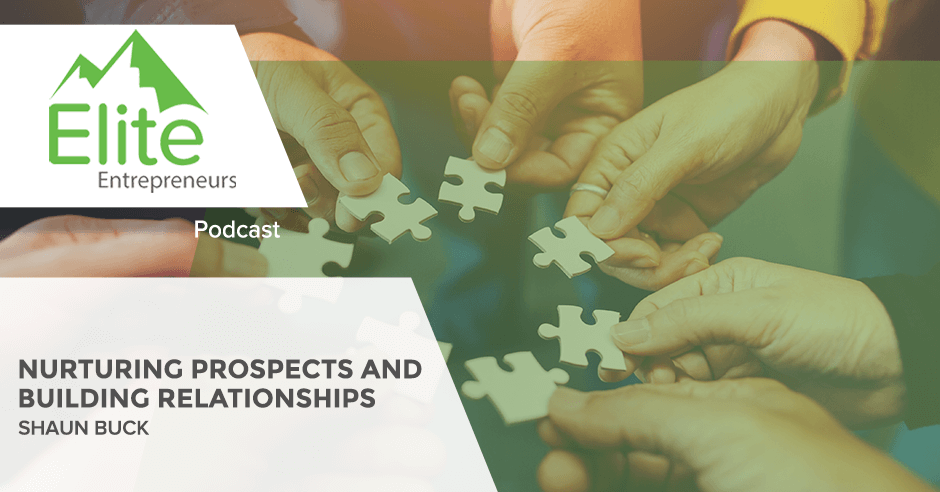Episode 24: Nurturing Prospects And Building Relationships, With Shaun Buck
Shaun Buck has been a successful serial entrepreneur for almost two decades. He currently owns and operates The Newsletter Pro, based out of Boise, Idaho. The Newsletter Pro has only been operating since 2011, but it has rapidly grown into the nation’s largest custom newsletter company, mailing millions of newsletters annually.
The Newsletter Pro has been recognized for its tremendous growth by Inc. Magazine, making the Inc. 500 list twice and the Inc. 5000 list once. The Newsletter Pro has also been named one of the best places to work in Idaho for the past four years. Shaun was named “Man of the Year” by the Leukemia & Lymphoma Society and is a successful business coach to owners of million-dollar businesses.
What the podcast will teach you:
- How Newsletter Pro helps customers through their online and offline newsletter, sending millions of newsletters per month
- Why offline, physical newsletters are still highly relevant even in the digital era, and how physical newsletters have high penetration and conversion rates
- How Newsletter Pro has grown to a 25,000-square-foot building with 75 employees in just nine years in business
- Shaun shares insights from his book Stop Losing Customers!: Transform Your Business, Life, and Profits by Getting Customers to Stay Longer, Spend More, and Cheerfully Refer!
- Why relationship-building was the key to Newsletter Pro’s growth and is the cornerstone of Shaun’s book, and what strategies Shaun uses to build strong relationships
- How Shaun made the transition from day-to-day operations to taking the time to build strategic relationships, and why properly nurturing prospects is vital
- How long-term nurturing of relationships for more than a year helped Newsletter Pro generate more than 1.2 million dollars in revenue
- What steps business owners can take to improve and smooth out their marketing strategy as they grow their business
- How to get a free copy of Shaun’s book Stop Losing Customers! and other free resources through the Newsletter Pro website
Resources:
- Complimentary copy of Stop Losing Customers! by Shaun Buck: Text “EEP” to (208) 269-9111
- Website: www.NewsletterPro.com
- Website: www.newsletterPro.com/freebook
—
I’m super excited for our guest because I’ve known this person for the last several years. I’m impressed with who he is as a person and also as a business owner. I’ll introduce to you why you should be excited to hear from him as an expert in marketing. His name is Shaun Buck. He is the Founder and CEO of Newsletter Pro. I’m honored and excited to have you as our guest, Shaun. Thanks for joining us.
Thanks for having me, Brett. I’m excited too.
Shaun’s business, the Newsletter Pro, is maybe a little different than what you would intuitively think from this new world of digital marketing. Please tell us a little bit about your business and why it is such an important thing in the overall marketing strategy and plan for businesses to still include things other than email and texts.
We are an online and offline newsletter company focusing on getting our customer’s messages and stories out there, building relationships, decreasing things like customer churn, increasing referrals, problems-solving and new products that are having to come out. We send out roughly 600,000 physical newsletters a month and millions upon millions of email newsletters for our clients.
We call our clients and interview ghostwriting content. It sounds like they wrote it. We taught them how to write a single word and provided them with the strategy to get them the best possible results, whether that be more referrals, better retention and cross-sells or upsells. It depends on what their goals are. We’ll help them with those strategies.
Why would it be important for them to make sure that they’re not only going digital? Why offline media like newsletters are still relevant? There is a variety of different reasons but some of the biggest things are the ability to get to everybody. Still, going through the mail, you can get roughly a 99% deliverability rate, as opposed to, if you’re talking about online or email marketing, you’re lucky to get 15% of people to see your message and 30% is considered phenomenal.
You can make a lot more money if you maximize what you already have. Share on X
The other big difference and it’s a metric, is how do we track it in the online world? Is time spent on site or consuming the media? One of the great things about an offline newsletter is the average person is consuming it for 12 to 15 minutes. That’s a long period that you have to get to know them, build relationships and have them get to know you, where you don’t get that via other marketing.
Not only do you not get reach via email or even Facebook and video under your page but you also can’t reach everybody. The time of consumption is very low. People fully understood what the power of attention was and the value of attention. They’d realize how profitable it is to be able to have that attention. It has been that way for many years.
Small businesses haven’t had to pay attention to it before but Facebook, all of a sudden, has a 30% decrease in active time onsite from its users. You better start shorting that stock because it’s about to plummet. That huge metric is the same thing. It can be true for us small business owners. It is that we’re going to get that time with them in a different way and process.
You taught us a lot about why everybody reading this blog should be thinking about doing something offline in addition to their online activities. You’re not saying, “Don’t do any of the online.” You shared with us that you do a lot of online outreach on behalf of your customers. It should be complementary to what they’re doing online to think about offline avenues for getting in front of people, engaging people and building relationships.
You’ve been doing this for some time. I’ve known you for the last several years. For our readers to get a feel for the type of experience you have as a business owner building a business, some of the volumes in the media are going out both online and offline every month on behalf of your customers. You’ve got a sizable business that you’ve grown over the last several years. When did you start the Newsletter Pro? I can’t remember how far back that goes.
We turned nine in 2020.

Nurturing Prospects: If people fully understood what the power and value of attention were, they’d realize how profitable it is to be able to have that attention.
You don’t have to share any revenue numbers but give us a sense of how many employees you have and how this has grown year over year. I want people to get a sense of how big you have gotten because you got some credibility to what you’re going to teach us here soon.
I’ve got about 75 employees who all work onsite at my building. It’s a huge building that I bought a few years ago, 25,000 square feet. We do all the production, printing and everything in the offices. We do over eight figures a year in revenue. We grew about 34% a year over in 2019. We had massive growth. We’re projecting another 35% year-over-year growth in 2020. It is what our numbers show. We should have no problem hitting that number. In quarter two of 2020, we hit right. We could see it even as high as a 50% growth. Even 35% on an eight-figure business is a lot of growth.
It’s more growth and some of our readers have is their total revenue because we serve all seven-figure businesses. They might be at $1 million to $2 million in revenue and you’re growing that rate. That gives us plenty of scopes and scale. You’ve grown quickly throughout that period and learned a ton of lessons. As our readers know, we’d like to talk to successful seven-figure growth companies. You’ve grown through that stage and have a ton of valuable information.
However, I’m going to make them wish that we had you on for a double episode but we’re not going to go there on this episode. We’re going to go to your expertise in marketing because not only have you successfully done this for your business and your customers but you teach this stuff more broadly. You’re constantly sharing messages, whether it be through blogs or your newsletters.
Let’s go ahead and talk about a book that you released. I’d love to have you tell us about the book and then we’ll get into some other marketing lessons from a seasoned entrepreneur who’s grown quickly. Your new book is Stop Losing Customers. Tell us about that and we’ll get into some of your lessons learned over the years in effective marketing.
It is a book that shows people how to scale and grow without necessarily having to go out and invest tons of more effort and marketing dollars into lead gen. Not to say that lead gen is not important. We do lead gen advertising on various platforms and stuff like that but it’s one of these things where many people aren’t getting all they can out of all they got. They aren’t realizing that they’re throwing good money at getting new leads in but neglecting some of the relationship marketing customer experience standpoints.
The consumer has all the power now. There are so many choices. They have so many places they can go and do business with or buy from. Share on X
As fast as they’re bringing them in, sometimes even faster, they’re losing the customers out the back door. We want them to realize that they could simply take what they’ve already got. Some of the leads that they’ve got help with conversions, sales, top sell and cross-sell. Reposition that lead if they’re not ready to buy widget A that they came in on, maybe they’re ready to buy widget B or something. You’ve got the things that come in where they’re not converting those leads, not getting them into referrals and not getting them into maximizing that customer lifetime value. If you want to succeed in business, you got to become good at the boring stuff.
Everyone thinks lead generation is the most exciting and amazing thing in the whole world. It can be a lot of fun but it’s also very expensive. There’s a lot of trial and error. There are a lot of people that fail at it. When you do it incorrectly or you don’t maximize those leads, you’re leaving massive amounts of money on the table. If you’re able to focus on your business more as a complete picture, as opposed to one component, which is a lead generation where everyone seems to gravitate towards, every problem gets solved by getting more leads.
That’s not necessarily the biggest challenge that the business has and to fix other areas, especially when they’re at $1 million, $2 million, $3 million to $5 million. You could make a lot more money if you maximize what you’ve already got. The focus of the book is on how we get retention, upsells and referrals out of them. Understanding the value of nurturing your leads to convert them to customers and nurturing your customers to get them to stay longer, refer more and spend more.
It doesn’t surprise me that you’ve come out with this book, given some of the histories we have. I’ve known you for a few years. When I first met you and you were doing some work to scale your business, I remember being struck by how gifted you are at relationships and how well you’ve weaved this into your business. A ton of your marketing effort, it seems like to me and your message is all about building great relationships. That’s how you can grow your business. Tell us a little bit about what role relationship building has played in growing your business and how it plays this stop losing customers focus that you’ve had in writing this book.
What’s happened is the economy has shifted here the way everything works. If I was to take you back a little bit in the ‘70s, ‘80s and even up to the mid-‘90s or so, the way the economy worked was businesses had all the information and power. You went to these businesses. You could wait for them to get your information at whatever period they wanted to get it to you. You had no control. If you didn’t like what they had to say, it’s too bad.
I was a kid but I heard stories where it used to be that you’d have to go in and test the electronics before you took them out of the store because there was no return policy. You got it home and it was broken. You’re screwed. You take it out, put the batteries in it, test everything and make sure it works. You were refunding that when you got back. If you got home and it didn’t work, you weren’t getting your money back. The business screwed consumers.

Nurturing Prospects: If you’re able to focus on your business more as a complete picture, as opposed to one component, which is lead generation, every problem gets solved.
The businesses felt all the power. At the time, they did have a lot of power. As the internet started to come on board, things shifted and we shifted to a price-based economy. Think of Priceline. Priceline was there. They’re over here talking about naming your price. They’re all these apps to check prices. Amazon is losing money to gain market share on books and, subsequently, other products. Everything was about having the cheapest possible price.
We fast forward a little more as we went into 2010 and beyond. As we get into 2020, we’ve moved into this relationship or experience-based economy. The consumer has all the power. There are so many choices and places they can go and do business they can buy from. Even if it’s a local-based business, there’s a bazillion of every business out there. Businesses have become this giant commodity.
Unless you want to compete by being the low-price leader and the Walmart of your industry, you have to make changes to what you’re doing and how you treat people. You can no longer have someone request information and take a week to get back to them with the basics of information. They’ve already bought from someone else at this point. If you don’t work at that, you don’t work on a great customer experience and a good experience, it would be negative reviews. They surely don’t refer. They don’t come back because you’re not the only butcher, baker or candlestick maker in the area or they can go online and order whatever it is that they need.
What happens is you need to change how you operate. Part of that is with relationships with your team, employees, customers, prospects, vendors and even outside partners or a referral network who is good to get you in that new business. You have to work those relationships. You also have to work with the customer and even all those other people, your team and vendors. You got to work on their experience. You’ve got to make it something that people enjoy and want to come into your location because they like the experience. They know they’re going to be treated right, whatever the case may be for your business. Otherwise, they’re going to go somewhere else.
There are many options or they’re only going to shop with you when they’re buying the least expensive items, the cheapest things or whatever you are known for from an inexpensive standpoint. By looking at how people are buying and what they’re looking for, some of the interesting things you’ll find are you’ve not only got the experience and relationship, which are key factors. By focusing on experience and relationships, you can raise prices. You no longer have to be the low-price leader. You can charge more for products and services.
If people are like, “I don’t know,” a great example of this is Apple phones versus Samsung phones. Your Apple phones are typically more expensive. In many cases, it doesn’t have the latest and greatest features but the experience in purchasing from Apple, using Apple devices and going in when you have a problem to one of their stores, to the Genius Bar, to their AppleCare, to everything, is amazing. Apple has built relationships with brand ambassadors. The people love them. They camp outside to get the latest iPhone.
Unless you want to compete by being the low-price leader, you have to make changes to what you're doing and how you treat people. Share on X
All these things play into allowing Apple to charge more money than their competitors for phones that realistically have less of the latest and greatest features in them. Their relationship with the consumer and their experience as a customer, whether it be purchasing, after the sale or using the device, is amazing. Tons of people pay a lot of significant extra money for their devices as compared to a Samsung, Motorola or some other device that they might decide to get. That’s one example.
I’ve got all these practical seven-figure business owners who, most of them, are still stuck in the business making it happen. Before we got on this call, you told me that not only do you have great growth in 2019 but you were able to take time off that you wanted or needed in significant amounts of it, which is another testament to how well you’ve built your business. A lot of the people reading this blog aren’t in that place yet.
How do you take this ideal as the picture you painted from Apple with high experience and price to go with it to, “I’m stuck in the business every day. How do I make this transition from where I am as a frantically running-around business owner in a seven-figure business to a place where I can spend more time in experience or relationship mode with customers, partners, employees and all the rest?” How do you start taking steps towards that?
This is how I operate a lot of my business life when I’m trying to figure something out. First of all, I’m going to analyze what assets do I have? Where are my small tweaks away from getting some leverage or getting ahead? You’re going to take a look at those assets. For example, one of them could be, what’s your front desk experience when they call in? People who call into my office, no joke, talk to the person at the front desk, Lauren. They’ll tell the project manager they’re talking to or the salesperson of the salesforce how amazing she is.
What’s their experience when they call in? What’s their experience when they need something, they’ve got questions or a problem? Look at those experiences. Another way is figuring out how you can get your message out there to as many people as possible. That’s one of the things that we do at Newsletter Pro. We interview the client and ghostwrite content. It sounds like they wrote it to help them get their message out there or whatever that happens to be that they need to deliver and get across. They can get that message out there by using leverage to outsource vendors like us.
Some of it could be putting it in your day but what I like to do is I like to make a list of what’s everything I can do. I’ll prioritize on what are my top couple of things? What are some easy things? If I had spent 4 hours, I could knock these 7 items off my task list. I could get ahead quickly. I’ll time block those four hours and go get them done. It’s all about finding where can you get leveraged fast, where can you get that maximum leverage and where can you outsource?

Nurturing Prospects: If you don’t work on a great customer experience, people will leave you. It would be negative reviews, and they surely won’t refer. You’re not the only butcher, baker, or candlestick maker in the area. They can just go online and order whatever it is that they need.
Most of us have to outsource at least some components of what it is that we do but outsource to quality. The rest of it is going down your list saying, “What’s the most important thing for me to fix that’s going to move that needle?” Make it the one thing that you’re working on, a quarterly priority or whatever system you use for goal planning, setting and accomplishment.
That’s how you’re going to do it but first, you got to take an inventory of what you need and where those assets are. The couple of things I can tell you that you need to know right off the bat that most people don’t have is they don’t have any nurture campaigns. They nurture maybe a prospect a little bit but always with the sales message. Think about most businesses. The messages that you put out there are, “Buy my stuff.” You put out some ads or product offerings or, “Pay your bill.”
Most business owners’ business operator is narcissists. That’s all about them. Everything revolves around the business and there’s nothing in there for the consumer. Think about Zig Ziglar and some of his teachings. One that I subscribe to and live by in my business is helping people get what they want and you’ll get what you want too.
For example, people who are on my list who have businesses. There are a lot of these readers types of people. We send them a physical eight-page marketing newsletter to help them grow their business for free every single month. When you get on the list, unless you indicate otherwise or asked to get off, we send that newsletter out for 48 months to you. Most people don’t realize they’re getting it for 48 months. They got to our number before we started reading people off the list unless they give us if they opt-out or don’t want it but we sent it for a long time and sat there adding value.
There are a few times when we’re pitching or asking for something. If it is 2 sentences at the bottom of a paragraph, as we close out an article, we’re sending 8 pages worth of actual usable content that we had in the past when we sold it. People paid monthly for it and we give it to them. We do this for a variety of reasons. You go to help enough other people get what they want and you get what you want. It works. We generated something like $1.2 million in new annual revenue from leads that were over 12 months old before they bought but they were getting this newsletter. They were getting content from us every month.
Over 12 months, you generated over $1 million in new revenue. Was that in 2019?
Help people get what they want, and you'll get what you want too. Share on X
Yes.
All those potential customers had been on your list for over a year. It’s because of your continued nurture, your good relationship building and your service to them that they finally said, “I’m going with these guys.”
At the end of the day, it’s when they’re ready to buy, not when you’re ready to sell to them. You have to sit there and be the person that continues to contact them, build those relationships and help them to stay in front of them. We’re the only person doing it. They called seven companies and a year later, you’re the only person who’s still following up with them. Almost by default, you’ll end up getting the business.
It’s one of these things where it has a huge impact. Does it happen overnight? It doesn’t. It’s a nurture campaign. If you’re not going to nurture those leads, they’re going to forget about you. No one is doing business with you if they don’t know who you are, what you do and you’re still in business. Most entrepreneurs only send out promotional material and people start ignoring them. Everyone is talking about time.
The nurture campaign is, “Are you ready to buy?” Three days later, “Are you ready now?” 12 months in, your list made up $1.2 million of new business in 2019. That’s fantastic. I don’t know if you’ve done this but if you had to, could you put a dollar amount to that investment over those twelve months? We already know what the return was which is $1.2 million. How much do you think you invested in that?
The cost probably on that particular thing is about $75,000.

Nurturing Prospects: Clients don’t tell you, but they’re not using you anymore. You’re not getting more revenue with them. And the problem is if you don’t go look into that and know why, then you’ll never fix the problem.
Let’s call it $120,000 for quick math on $1.2 million. That’s a pretty good return right there.
It was inexpensive. The thing is I’d already paid all the money to get the leads and had that sunk cost. It’s almost like when you think about stocks. It’s dollar cost averaging. I’m putting out a little more money to get more money out because I’d already spent the money on the leads. Here I am putting in a little more money to get a lot more money back out.
I don’t know the math and we don’t have to go through it but let’s say you threw in the sunk cost amount. I can’t imagine that it made you a poor return on that $1.2 million. Even if you counted all the money that it costs to generate those leads, to begin with. As a sunk cost, that’s what it is.
What it did is brought down my overall cost to get a new customer. It ended up bringing it down because I spent more money to get those leads by far. Some are the money I invested into getting some of them to convert. I spent way more money getting them. What happens is you’ve got all these costs in getting these leads. I have to take that spend and either say, “I’m not going to get anything from it or put a little more money at it.” It’s like retargeting. If you were going to put some money into retargeting, you’re not going to be like, “That wasn’t worth it. Those were leads they weren’t going to convert.”
By putting a little more money out of them, I ended up getting a lot more money out of them. That $1.2 million is the first year worth of what they spend in them. Our average client base is for almost four years, which for a marketing company is a crazy long period. That’s almost four years that they’re going to be with us. That was $1.2 million in the first 12 months that they’re with us. When you think about if they stay what our average customer stays, which will be 4 years, it’s not $1.2 million. It is $4.8 million.
That doesn’t even account for referrals to others or upsells. That’s doing straight math. Shaun, as a marketing company, to be able to keep people for years like that is extraordinary. Let’s learn some of the things that you’ve been able to do for your customers but in general, principles as seven-figure business owners start to hit ceilings in their growth because you’ve grown your business through this. What are some of the things that they get stuck on from a marketing standpoint? It’s never going to be perfectly smooth but how do they make it less rocky as they’re trying to continue to grow through seven figures from a marketing standpoint?
If you're not going to nurture those leads, they're just going to forget about you. Share on X
There are a couple of things. At some point, a lot of times, the people selling in the beginning, especially even up to the first few million bucks, is the entrepreneur doing a lot of the selling or they’re the sales manager, sales trainer, lead sales person or closer. You have to get a real sales system and process in place. You can’t just continue to wing it with the entrepreneur taking that on because as your business grows so do your duties as CEO.
If you’re winging it from a sales standpoint where it’s you or one other salesperson who sucks, you take most of the calls, consultations or whatever like that, there’s a cap there and you’re going to burn out on that and reach that cap way faster than you’re possibly going to. You’re going to be able to grow through whatever that revenue portion is that you’re stuck out.
One area that you need to focus on is what your sales team, process and systems look like. The next area is what is your follow-up? How long are you nurturing these leads? How long are you educating them? How much value are you adding into their lives compared to how much you’re taking out? You’re in the sense of only making offers or whatever the case may be. The more value you can add to their lives via content. This is online content, offline content, Facebook content, Instagram content, wherever it is because you got to catch them wherever they’re going to be, not where you want to catch them at.
You do need at least one catch-all that can get the majority of them. There’s nothing out there that can get roughly a 99% deliverability rate to your prospects and customers other than print it. It doesn’t exist anywhere else. If you’re not putting some money into that, you’re leaving massive amounts of money on the table. It’s important that you focus somewhere or somehow on getting that message out to everybody and nurturing them. If they call you, they’re interested but they decide they don’t need your product or service, need it or are not educated enough, that is a huge reason people don’t buy it.
People get paralyzed with fear of the unknown. There’s so much fear. People stop them dead in their tracks. They don’t want to move forward. They’re scared of losing the money or whatever it is for making a bad decision. Entrepreneurs don’t understand that because we have to push through fear a lot of times, make decisions and go forward but you have to understand that that’s not normal for most people. You have to nurture it.
You got to remember, even if you told them once about something, they don’t remember what you’ve said. You have to continue to work with them and process this with them. It’s a follow-up. It’s making sure you have good sales systems. Inspect what you expect. If no one’s listening to sales phone calls, how do you tell if your salesperson sucks?

Stop Losing Customers!: Transform Your Business, Life, and Profits By Getting Customers To Stay Longer, Spend More, and Cheerfully Refer!
We brought in sales training and coaching instead of it being me coaching. I was like, “I’m a good salesperson. I can coach them.” The problem was I didn’t have time to coach them and make it happen. That was the problem. It didn’t work out the way I thought it was going to work out. I found that we needed something more than that. We figured out where the holes were in our system. How do we stop the customers from going out the back door? Where are they disgruntled?
A lot of people will call up and cancel. I’m a big believer that if the customers cancel on you, like call and say they’re not coming anymore, whatever the first reason they give you is probably BS like, “I don’t have any money.” “Assuming you had money, what other reasons contributed to you deciding not to use my service anymore?” When you get to that question, you’re starting to get to the truth. “ I have these problems over here and there. No one responded to the email.”
It probably had nothing to do with money for most people. You got to get to the true cause and reason that people are canceling. You’ll need to plug those holes and stop that stuff. You can’t have 20 customers coming in the front door and 19 leaving out the back door and expect you’re going to see any growth there. Most people don’t even know what their churn number is. They have no idea how many customers are losing. That’s a problem.
If you have customers who don’t cancel, you need to have a point in time where you realize that these are the people that have not come in 4 months and 2 weeks. You’re making phone calls and sending letters. You’re trying to get them back, either reactivated because they’re likely canceled. They didn’t tell you but they’re not using you anymore. You’re not getting more revenue with them.
The problem is if you don’t go look into that and know why, you’d never fix the problem. You’re making it so more customers cancel in the future. More of your marketing go away or has to get spent on replacing those people to stay even. Another huge area where entrepreneurs are missing out is they see 1 new customer as 1 new customer. The reality is usually you have to get a new customer and they have to use a certain number of times if they’re good and loyal.
They’re over here high-fiving each other. We’ve got 27 new customers in a month, knowing that only 70% of them are going to return. You didn’t get 27 new customers. You got 19 new customers in a month and you lost 22. Those high fives you’re giving each other about how great of a month you’re having are not great anymore when you realize that you lost three customers.
The other thing I tell people that they should focus on when they’re talking about trying to get ahead is the concept not of churn but revenue churn, even to try to get it to net-neutral revenue insurance. That’s our goal as a company. We looked at the number of customers that leave but the bigger question is how much revenue? The customer leaves who are spending $800 a month is not equal to customers spending $5,000 a month. We want to look at what is that revenue churn. How is our upsell process working? Are customers buying more? Can we get to net-neutral revenue insurance?
If I lose $10,000 in monthly reoccurring revenue from customers canceling, do I gain at least $10,000 in customers spending more with us because they bought other products and services? They increase their list size, whatever it happens to be. If we focus on a couple of these areas, we can see huge growth in our business but without drastic increases in our marketing spend.
You have to get a real sales system and process in place. As your business grows, so do your duties as CEO. Share on X
You said way more than I could summarize here. The one thing that stuck with me is that our readers and your chief among them are not normal. They think that everybody else is going to behave like them, push through fear and make some important decisions to buy your product or service right away. That’s not the case. It’s not true.
You aren’t all normal. You’re all special. Shaun is not just one of you that way but he laid out for you a gold mine. There was a strong vein in there with several key points. You have to get your sales capability upgraded. It can’t rest on you anymore. You have to have a defined system and process. Get the right team around that.
You’ve got to nurture in the ways that Shaun has been talking about throughout this episode. You must continue to be in front of people, add value and be a trusted source of information and value. They can buy but only when they’re ready. You have to look at all these different places in your customer experience, from when they sign up with you to when they call the cancel and why are they doing that to all the different touchpoints.
Shaun, thank you. You touched on many things. I hope our readers will reread it. Tell us one more time about Stop Losing Customers, where they can find it and how they can get connected to that. You mentioned a newsletter that you send out that people can get tons of value from you every month. Tell us how to connect that way as well.
The best thing for them to do is text in so they can touch off them for this book. We’ll send it to them as a complimentary, including shipping handling and everything. Text the word EEP to (208) 269-9111. What will happen is there’ll be able to go through this little process that we have where they’ll ask them a couple of questions via text, get all their information, where they want us to send it to, what’s their name and all that stuff.
From there, we’ll ship it out the next business day, complimentary for your readers. This is not a book that we’re giving away for free normally. It will be sold but a brief promotional window here where we’re doing it for a couple of special places for you guys and your show where we’re giving it complimentary, even covering the shipping and handling ourselves.
Everybody texts EEP to that number and get your book from Shaun. It’s full of insights to elaborate further on a little bit of what he shared to help you close more of the business that you want to close. More importantly, nurture, follow up and not lose the people you are losing because of poor or lack of follow-up or nurturing. There are many opportunities for you to grow your business in the ways that Shaun has outlined. I appreciate you coming to be an expert for us, Shaun. Maybe we’ll have you back another day as one of our business owner interviews but as an expert, you shared a wealth of knowledge. Thank you.
Thank you. I appreciate it.
They can text in and start to have a relationship with you and your business.
Get the newsletter too.
Are there places online on your website or social that you would want people to go and learn about you or connect?
They can go to NewsletterPro.com. If they’re interested in newsletters, they should go to NewsletterPro.com/FreeBook. That will also get them another one of my books. It comes out in a cool shock and awe package. If they’re in marketing, they’ll love to see that. This package has generated millions of dollars and new business for us. If you’re into marketing, go enjoy that.
Plus, you’ll get to see a little bit about how we do things from a newsletter standpoint and how we can help your business grow. They can go there and check that out. Get one or both of the books. If they have questions, go to the website, reach out to us or call in, whatever’s easiest for you. We’ll be happy to answer all your questions and take care of them.
That wraps up another episode. Please, as always, as you read, review, rate and share this with others. We want to help as many seven-figure business owners as we can. We’ll continue to bring great guests like Shaun, who will be successful seven-figure business owners or experts that are going to help you with the things that you have to do if you want to grow your seven-figure business beyond what it is. We’ll talk next time. Keep reading. Thanks.
Important Links
Want to listen to more? View all episodes here >



